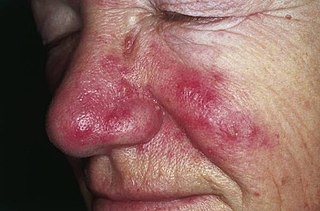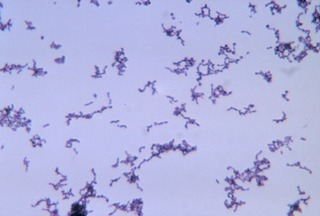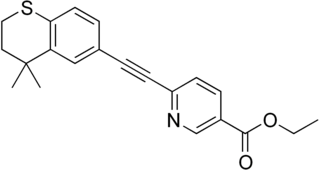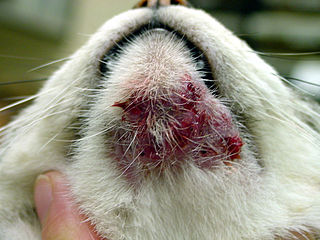
Acne, also known as acne vulgaris, is a long-term skin disease that occurs when hair follicles are clogged with dead skin cells and oil from the skin. It is characterized by blackheads or whiteheads, pimples, oily skin, and possible scarring. It primarily affects areas of the skin with a relatively high number of oil glands, including the face, upper part of the chest, and back. The resulting appearance can lead to anxiety, reduced self-esteem and, in extreme cases, depression or thoughts of suicide.

Sebaceous glands are microscopic exocrine glands in the skin that secrete an oily or waxy matter, called sebum, to lubricate and waterproof the skin and hair of mammals. In humans, they occur in the greatest number on the face and scalp, but also on all parts of the skin except the palms of the hands and soles of the feet. The type of secretion of the sebaceous glands is referred to as holocrine. In the eyelids, meibomian glands, also called tarsal glands, are a type of sebaceous gland that secrete a special type of sebum into tears. Fordyce spots are ectopic (misplaced) sebaceous glands found usually on the lips, gums and inner cheeks, and genitals. Areolar glands surround the female nipples.

Cutibacterium acnes is the relatively slow-growing, typically aerotolerant anaerobic, Gram-positive bacterium (rod) linked to the skin condition of acne; it can also cause chronic blepharitis and endophthalmitis, the latter particularly following intraocular surgery. The genome of the bacterium has been sequenced and a study has shown several genes can generate enzymes for degrading skin and proteins that may be immunogenic.

Spironolactone, sold under the brand name Aldactone among others, is a medication that is primarily used to treat fluid build-up due to heart failure, liver scarring, or kidney disease. It is also used in the treatment of high blood pressure, low blood potassium that does not improve with supplementation, early puberty in boys, acne and excessive hair growth in women, and as a part of feminizing hormone therapy in transgender women. Spironolactone is taken by mouth.

Rosacea is a long-term skin condition that typically affects the face. It results in redness, pimples, swelling, and small and superficial dilated blood vessels. Often the nose, cheeks, forehead, and chin are most involved. A red enlarged nose may occur in severe disease, a condition known as rhinophyma.

Propionibacterium is a gram-positive, anaerobic, rod-shaped genus of bacteria named for their unique metabolism: They are able to synthesize propionic acid by using unusual transcarboxylase enzymes.

Hyperpigmentation is the darkening of an area of skin or nails caused by increased melanin.

A milium, also called a milk spot or an oil seed, is a clog of the eccrine sweat gland. It is a keratin-filled cyst that can appear just under the epidermis or on the roof of the mouth. Milia are commonly associated with newborn babies but can appear on people of all ages. They are usually found around the nose and eyes, and sometimes on the genitalia, often mistaken by those affected as warts or other sexually transmitted diseases. Milia can also be confused with stubborn whiteheads.
Acne keloidalis nuchae (AKN) is a destructive scarring folliculitis that occurs almost exclusively on the occipital scalp of people of African descent, primarily men.

Tazarotene is a third-generation prescription topical retinoid sold as a cream, gel, or foam. Tazarotene is a member of the acetylenic class of retinoids. This medication is approved for treatment of psoriasis, acne, and sun damaged skin (photodamage). It is commonly sold in two concentrations: 0.05% and 0.1%.

A comedo is a clogged hair follicle (pore) in the skin. Keratin combines with oil to block the follicle. A comedo can be open (blackhead) or closed by skin (whitehead) and occur with or without acne. The word comedo comes from the Latin comedere, meaning 'to eat up', and was historically used to describe parasitic worms; in modern medical terminology, it is used to suggest the worm-like appearance of the expressed material.
Perioral dermatitis is a type of skin rash. Symptoms include multiple small (1–2 mm) bumps and blisters sometimes with background redness and scale, localized to the skin around the mouth and nostrils. Less commonly the eyes and genitalia may be involved. It can be persistent or recurring and resembles particularly rosacea and to some extent acne and allergic dermatitis. The term dermatitis is a misnomer because this is not an eczematous process.

Pemphigus vulgaris is a rare chronic blistering skin disease and the most common form of pemphigus. Pemphigus was derived from the Greek word pemphix, meaning blister. It is classified as a type II hypersensitivity reaction in which antibodies are formed against desmosomes, components of the skin that function to keep certain layers of skin bound to each other. As desmosomes are attacked, the layers of skin separate and the clinical picture resembles a blister. These blisters are due to acantholysis, or breaking apart of intercellular connections through an autoantibody-mediated response. Over time the condition inevitably progresses without treatment: lesions increase in size and distribution throughout the body, behaving physiologically like a severe burn.

Feline acne is a problem seen in cats primarily involving the formation of blackheads accompanied by inflammation on the cat's chin and surrounding areas that can cause lesions, alopecia, and crusty sores. In many cases symptoms are mild and the disease does not require treatment. Mild cases will look like the cat has dirt on its chin, but the dirt will not brush off. More severe cases, however, may respond slowly to treatment and seriously detract from the health and appearance of the cat. Feline acne can affect cats of any age, sex or breed, although Persian cats are also likely to develop acne on the face and in the skin folds. This problem can happen once, be reoccurring, or even persistent throughout the cat's life.
Acneiform eruptions are a group of dermatoses including acne vulgaris, rosacea, folliculitis, and perioral dermatitis. Restated, acneiform eruptions are follicular eruptions characterized by papules and pustules resembling acne. The hybrid term acneiform, literally, refers to an appearance similar to acne.
Comedone extraction is a widely used method of treatment for acne vulgaris. A dermatologist or cosmetologist may extract blackheads using gentle pressure around the pore opening, and whiteheads by incision with a large needle or a blade.
Acne conglobata is a highly inflammatory disease presenting with comedones, nodules, abscesses, and draining sinus tracts.
Eruptive vellus hair cysts are small lesions that occur most often in the chest wall, abdomen and extremities, often with a crusted surface. EVHC may occur randomly, or it can be inherited as an autosomal dominant trait. The condition affects males and females equally, and sporadic cases usually appear at 4–18 years of age. The cysts appear similar clinically to steatocystoma multiplex, as well as acneiform eruptions and milia. Therapeutic techniques that are safe and effective are rare, with incision and drainage being the primary form of treatment when sporadic regression does not occur.

Adapalene/benzoyl peroxide is a prescription medication combination for the treatment of severe acne vulgaris; marketed by Galderma under the trade name Epiduo. Its trade name in Canada is TactuPump, where it was previously known as Tactuo. It consists of a combination of adapalene (0.1%) and benzoyl peroxide (2.5%) in a topical gel formulation. Meta-analysis of clinical trials has shown this combined therapy to be more effective than either of its ingredients by themselves.

Clascoterone, or cortexolone 17α-propionate, or 11-deoxycortisol 17α-propionate, is a synthetic steroidal antiandrogen – specifically, an androgen receptor antagonist – that is under development by Cassiopea and Intrepid Therapeutics for use as a topical medication in the treatment of androgen-dependent conditions including acne vulgaris and androgenic alopecia. It is the C17α propionate ester of 11-deoxycortisol (cortexolone); C17α esters of 11-deoxycortisol were unexpectedly found to possess antiandrogen activity, and cortexolone 17α-propionate was selected for development based on its optimum drug profile.














